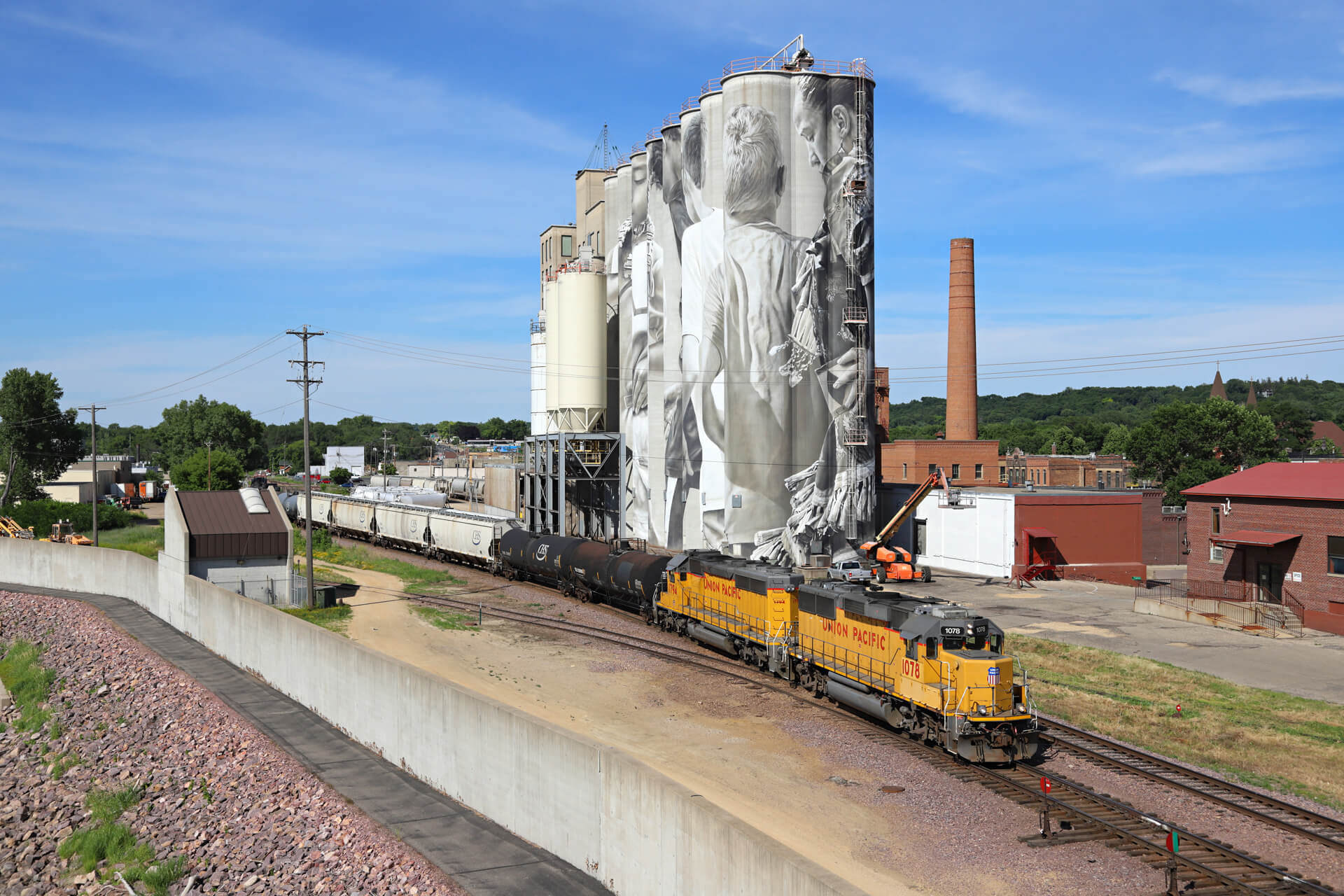Introduction
The City of Mankato is studying the potential for a railroad quiet zone at 14 different crossings on the Union Pacific rail line. If established, trains would no longer routinely sound their horn as they travel over each crossing and would only sound their horn in the case of an emergency. To achieve the quiet zone, the City must install many additional safety improvements such as crossing gates and medians, some of which may impact adjacent driveways or access points. The City will be developing multiple improvement options for each crossing and is looking for public feedback to help guide our design process.
Live Online Meeting
The project team will be walking through this information live on
Thursday, December 3 from 5 p.m. – 7 p.m.
Join us to learn about the study and have your questions answered. Use this link to participate at the time of the event and enter the event password: MankatoRR
How to Navigate
Click the "Previous" and "Next" arrows to go forward or backward. Use the navigation bar on the left side of your screen to revisit any part of the meeting.
How to Participate
- Click the arrows on the right of your screen to go forward or the left to go backward. Use the navigation bar on the left side of your screen to revisit any part of the meeting.
- Provide a comment at any point by clicking the “Comment” button at the top right of your screen. You may close the form to continue through the slides. Once finished, please make sure to hit "Submit" to confirm that your comment is sent to the project team.
Project Area
What is a Quiet Zone?
Defining Quiet Zones
A quiet zone is…
A quiet zone is an area with reduced train horn noise. The following helpful definitions come from the Federal Railroad Administration:
- Under the Train Horn Rule (49 CFR Part 222), locomotive engineers must begin to sound train horns at least 15 seconds, and no more than 20 seconds, in advance of all public grade crossings.
- In a quiet zone, railroads have been directed to not sound their horns when approaching public highway-rail grade crossings. Train horns may still be used in emergency situations or to comply with other federal regulations or railroad operating rules.
A quiet zone is not…
A quiet zone does not mean that all train horns will be stopped.
- Emergencies: Locomotive engineers may still sound the horn in case of emergencies, such as a vehicle, person, or even an animal on the tracks or in the crossing.
- Yard operations: Locomotive engineers are still required to sound the horn to signal yard operations (backing up, stopping, etc.). However, these horns are much less intense than horns used for rail crossings.
Federal Railroad Administration Train Horn Rule Background
For many years, quiet zones (then known as whistle-free or whistle-ban crossings) were implemented at the discretion of local roadway jurisdictions. Following a rise in the number of crashes linked to these crossings, Congress mandated the federal regulation of horns at grade crossings.
In 2005, the FRA released the Train Horn Rule (49 CFR Part 222) mandating the use of train horns at public, vehicular crossings. However, the Train Horn Rule also provided a means of implementing a quiet zone under certain conditions.
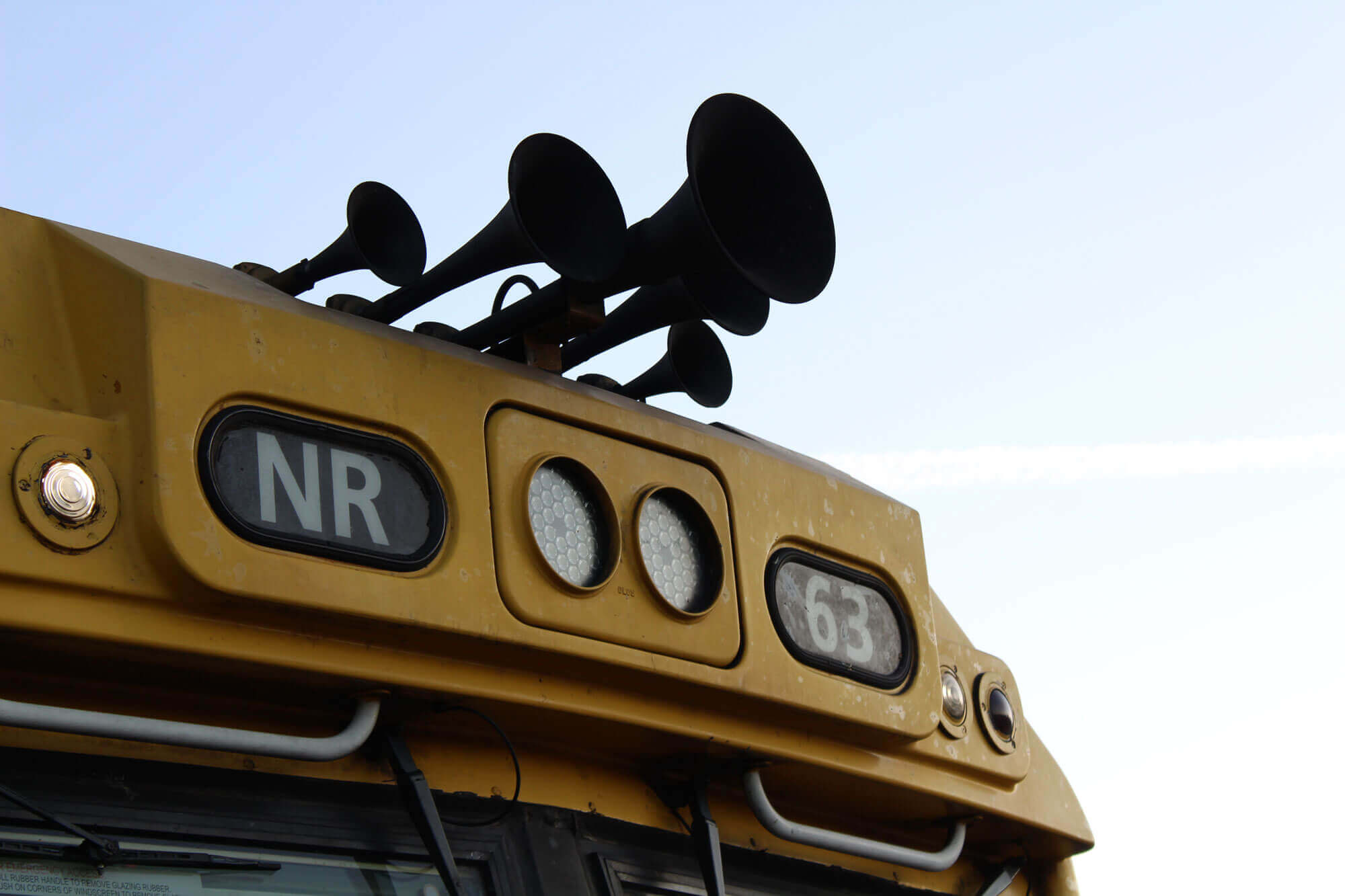
Minimum Requirements
Quiet Zone Qualifications
In order to qualify for a quiet zone, each public, vehicular crossing must be equipped with gates, flashing lights with power out indicators, and Constant Warning Time (CWT) detectors.
Review the table below to see the status of those safety features at the existing Mankato rail crossings.
Mankato Rail Crossings
Some key takeaways that have been identified:
- Three crossings do not have any of the minimum requirements.
- Three crossing have gates and lights, but do not have CWT detectors.
- Pedestrian and private crossing are to be evaluated by a diagnostic team to determine the minimum warning devices.
- Upgrades to the warning devices also typically include reconstruction of the crossing surface if it is an older material (timber) or is in poor condition.
| Street | Crossing Type | Gates | Lights | CWT |
|---|---|---|---|---|
| Private | Private | N/A | N/A | N/A |
| Industrial Rd (Yard Tracks) | Public | No | No | No |
| Industrial Rd (Main Line) | Public | Yes | Yes | Yes |
| Private | Private | N/A | N/A | N/A |
| 3rd Ave | Public | Yes | Yes | Yes |
| Pine St and 5th Ave | Public | Yes | Yes | Yes |
| Rock St | Public | Yes | Yes | No |
| Elm St/Willow St (Yard Tracks) | Public | No | No | No |
| Elm St | Public | Yes | Yes | No |
| Private | Private | N/A | N/A | N/A |
| Pedestrian | Pedestrian | N/A | N/A | N/A |
| Owatonna St | Public | Yes | Yes | No |
| Hubbell Ave | Public | No | No | No |
| Amos Owens Ln | Public | Yes | Yes | Yes |
Risk Analysis
FRA Risk Analysis
Once each public vehicular crossing in the corridor meets the minimum warning device requirements, the next step is to determine what safety improvements are needed for the crossing to qualify as a quiet zone. The FRA determines this qualification based on a standardized risk analysis formula. Generally speaking, when the train horns cease, the FRA formula assumes that the risk at a crossing increases. Installing additional safety improvements is a way to help reduce this risk back to levels that are as safe (or safer) than existing conditions.
The FRA allows quiet zone qualification by meeting one of two risk thresholds:
- Risk Index With Horns (RIWH): This risk level is equivalent to the existing risk levels with horns sounding and no additional improvements.
- Nationwide Significant Risk Threshold (NSRT): This risk level is the national average of all non-quiet zone public grade crossings equipped with gates and lights.
Corridor-wide Averages
Importantly, the FRA does not require additional safety improvements at every crossing. The risk is measured using a corridor-wide average of the risk at all crossings included in the proposed quiet zone.
Quiet Zone Implementation Process
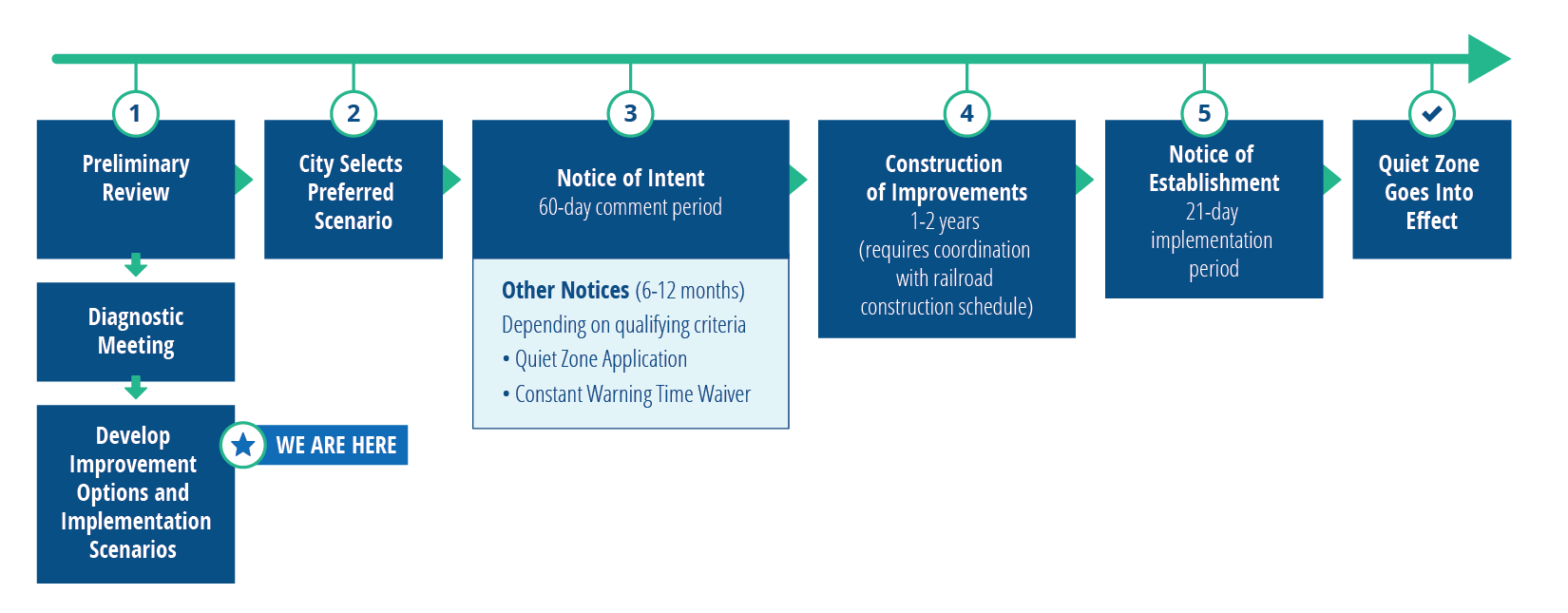
Click the image above to enlarge.
Safety Improvement Options
The following section provides a brief overview of eight available improvement options in three different categories. For each option the risk reduction value and estimated costs have been included.
Category 1: Supplemental Safety Measures (SSMs)
These improvement types have been pre-approved by the FRA as quiet zone treatments. They do not require any additional approval steps, such as a Quiet Zone Application.
Four-quadrant gates
This improvement adds a second set of gates to completely block the crossing. Although there are minimal impacts to adjacent properties, but this improvement has the highest cost. The cost and construction schedule are determined by the railroad.
- Risk Reduction: 77-82%
- Cost: $600k-$900k
- Annual Maintenance Costs: $5,000-$10,000

Medians
This improvement adds a raised median on the roadway approaches to the crossing. The median should be 100’ long measured from the crossing gate. Shorter medians can be used in cases where roadway intersections or commercial driveways would be blocked. Medians less than 60’ require a Quiet Zone Application to the FRA. This is a cost-effective improvement, but it may impact adjacent private driveways.
- Risk Reduction: 80%
- Cost: $30k-$100k

Channelization
This improvement functions similarly to median improvements but can be used in locations where roadway width is a concern. While these are the lowest cost improvement, they have the potential for durability issues, particularly with snowplows. Damaged sections of channelization must be repaired to maintain quiet zone compliance.
- Risk Reduction: 75%
- Cost: $10k-$30k
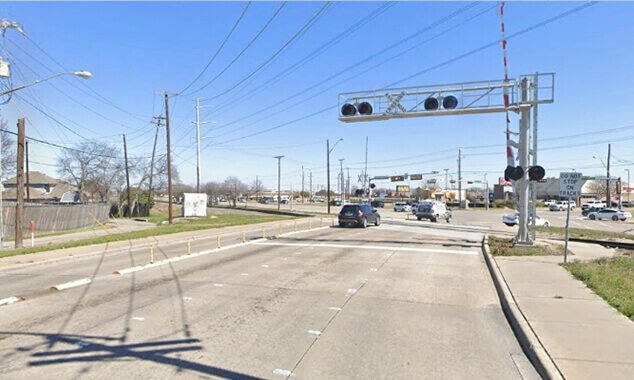
Closure
Closing the crossing to all vehicular and pedestrian traffic completely eliminates the risk at the crossing but is very impactful to circulation and neighborhood access. Potential financial incentives from MnDOT and UP (typically $15k) can often make this a cost-neutral improvement option.
- Risk Reduction: 100%
- Cost: $0-$20k
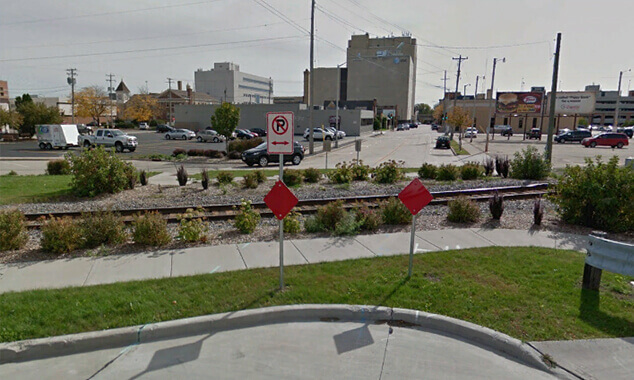
One-Way Streets
One-way street configurations allow the crossing to be fully blocked by two gates on one side. These improvements are most often used on existing one-way roads.
- Risk Reduction: 82%
- Cost: Variable
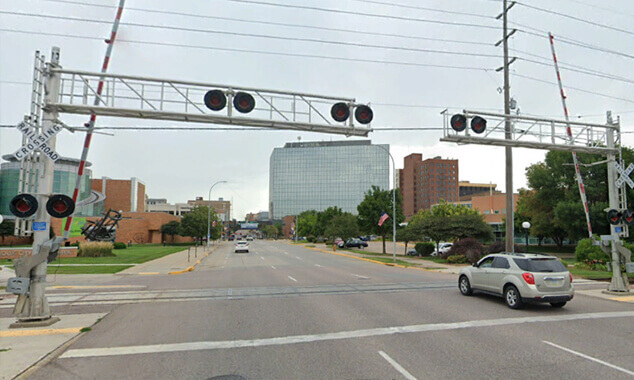
Category 2: Alternative Safety Measures (ASMs)
These improvement types are allowed by the FRA but require the submittal of a Quiet Zone Application for approval. This application can add a year or more to the implementation process.
Reduced length medians/channelization
Identical to the median improvements described previously, but which include medians less than 60’ or where an roadway intersection or commercial access is located within 60’ of the crossing gate.
- Risk Reduction: 25-82%
- Cost: $20k-$100k
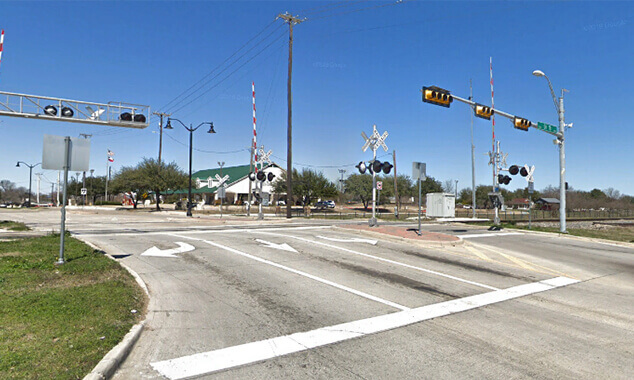
Three-quadrant gates
A hybrid combination of the four-quadrant gate and median options, this option includes two gates one side of the crossing and a median on the other. There are typically not substantial cost savings when compared to a four-quadrant gate option.
- Risk Reduction: 40-80%
- Cost: $400k-$800k
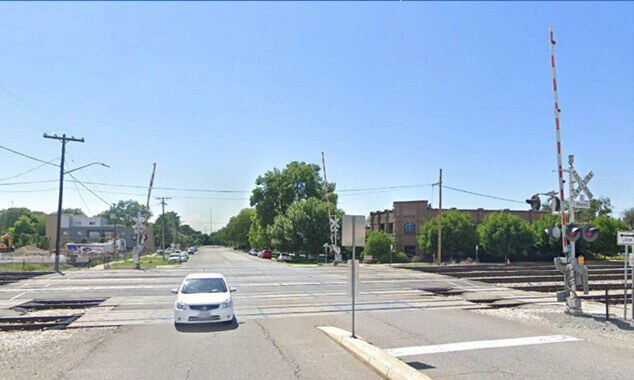
Category 3: Other
Wayside horns
This improvement emits a train horn sound at the crossing in place of the train horn. The sound is more focused at the crossing location and is directed down the roadway approaches to have less impact on the adjacent areas. This is an uncommon option since it does not actually eliminate the horn sounding.
- Risk Reduction: 40-80%
- Cost: $100k
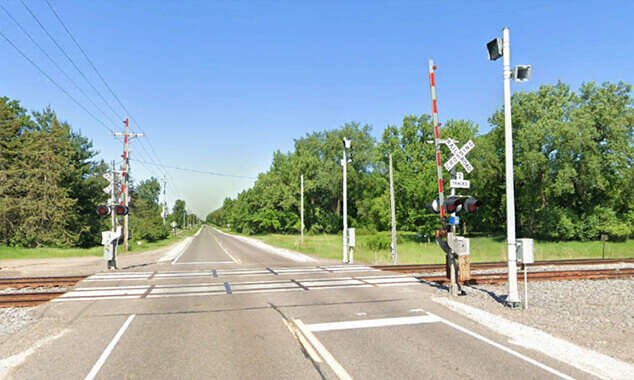
Proposed Improvements
Instruction and Definitions
The proposed improvement options for each railroad crossing are presented below. Click each image to enlarge. After reviewing the options, please provide your feedback about what will work best at that crossing.
SSS: Supplemental Safety Measures
ASM: Alternative Safety Measures
Design Concepts
Please note: These options are presented as preliminary conceptual layouts. Additional construction details such as signing and striping will be further developed at a future date after feedback has been received from the public and other stakeholders. Some options will also require coordination with other agencies and jurisdictions such as Blue Earth County, South Bend Township, and the Army Corps of Engineers.
Amos Owens
Baseline:
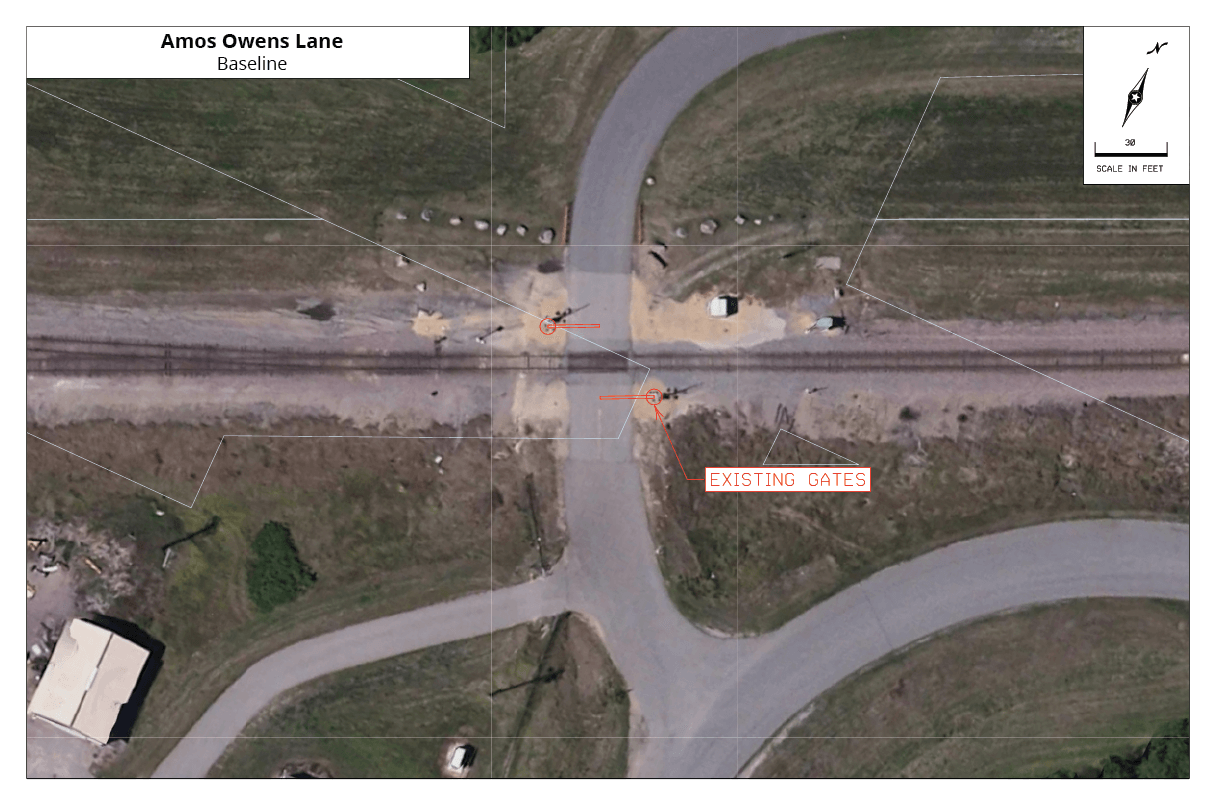
Option 1: Four Quadrant Gates
Cost: $682,784
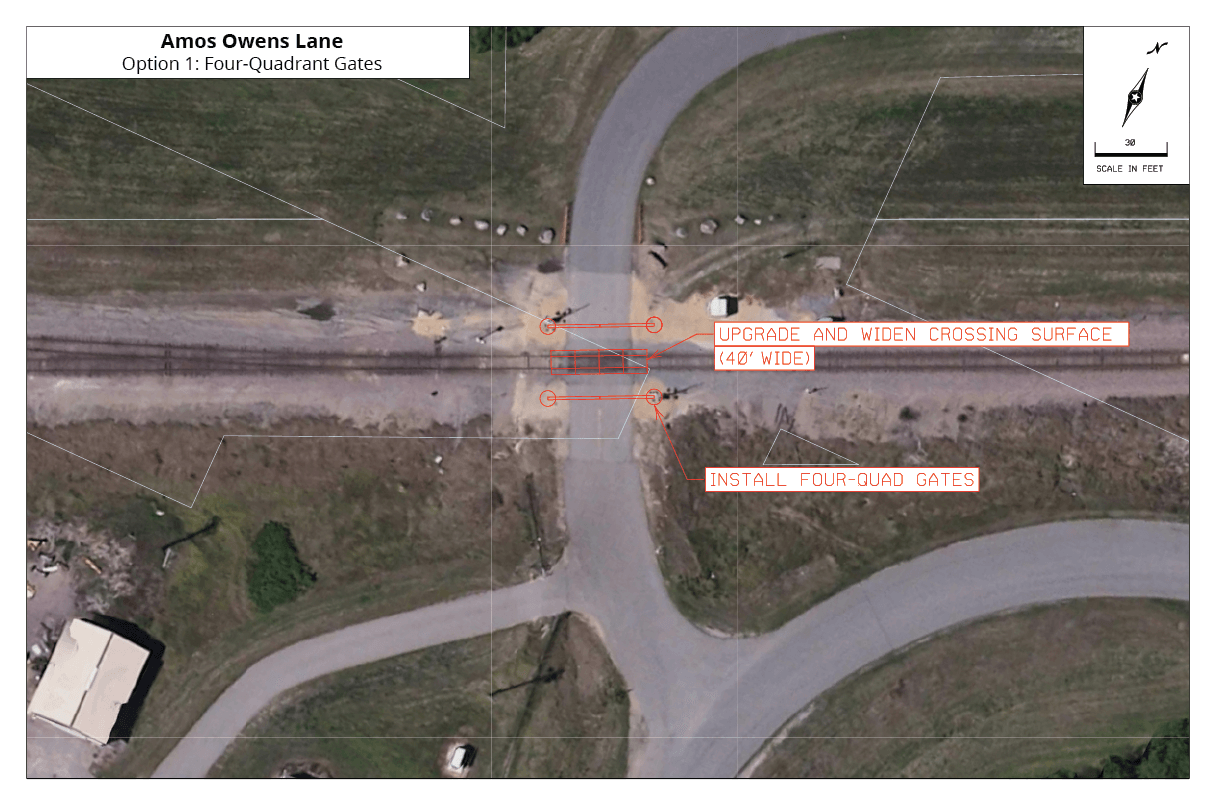
Option 2: Medians
Cost: $162,386
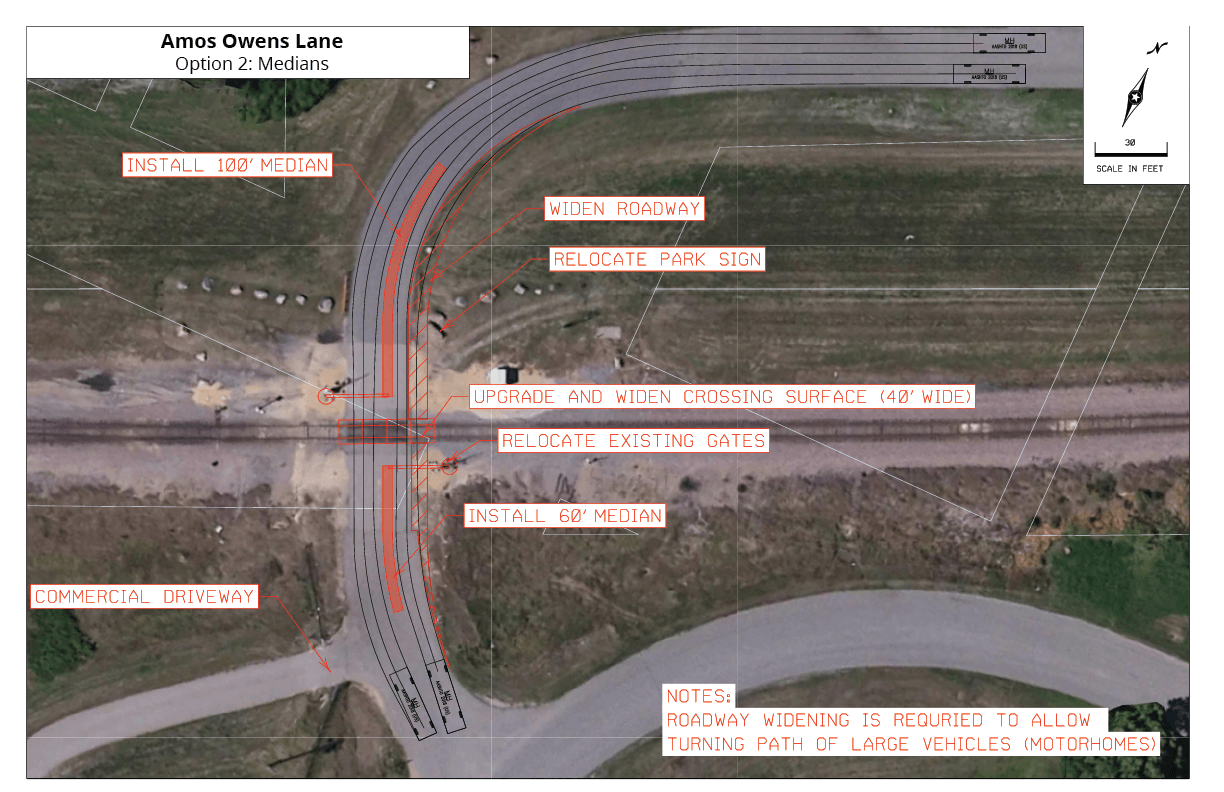
Your Feedback:
Hubbell
Baseline:
Cost: $649,928
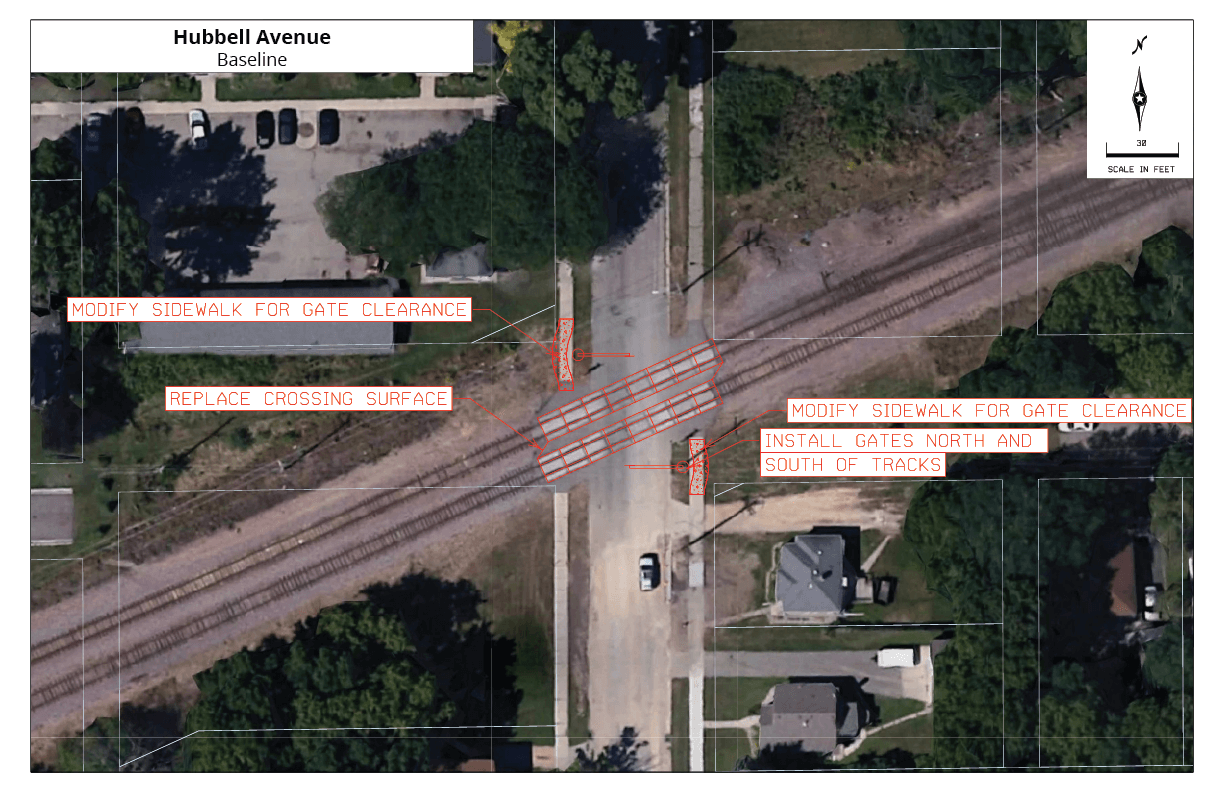
Option 1: Medians
Cost: $654,458
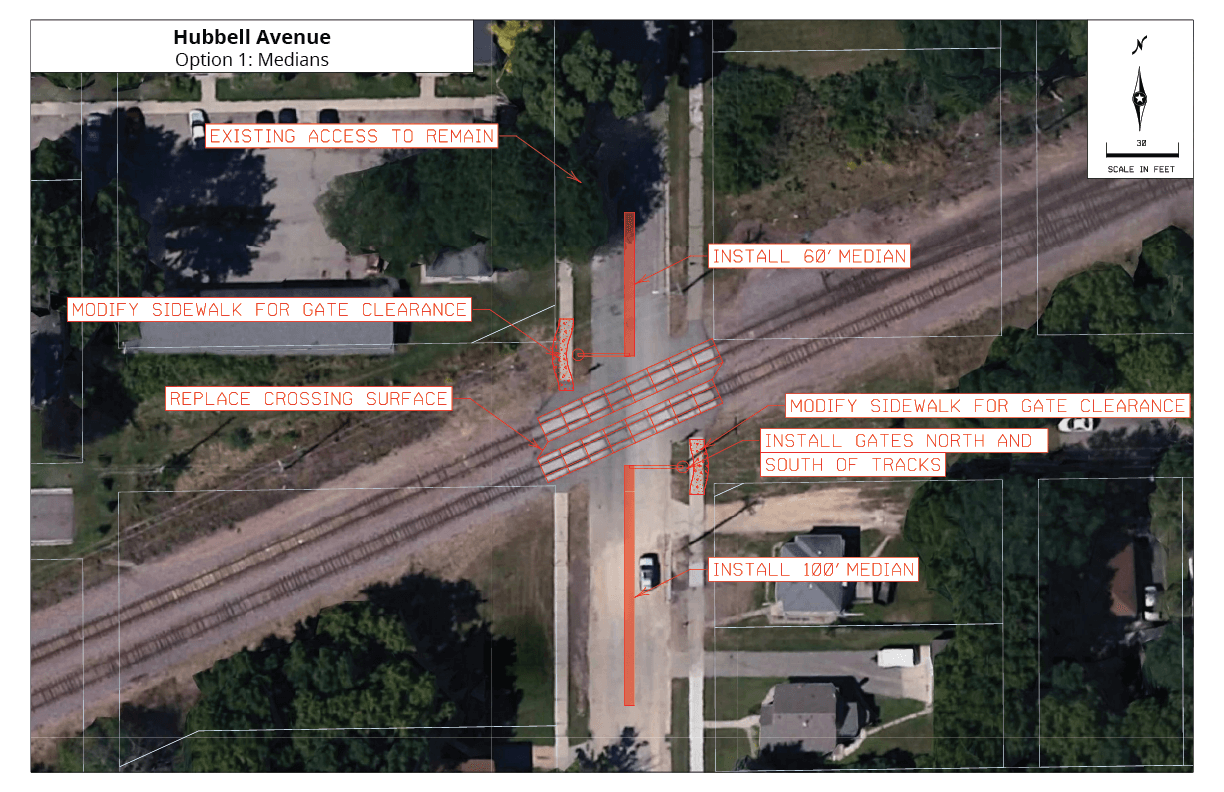
Option 2: Closure
Cost: $29,901
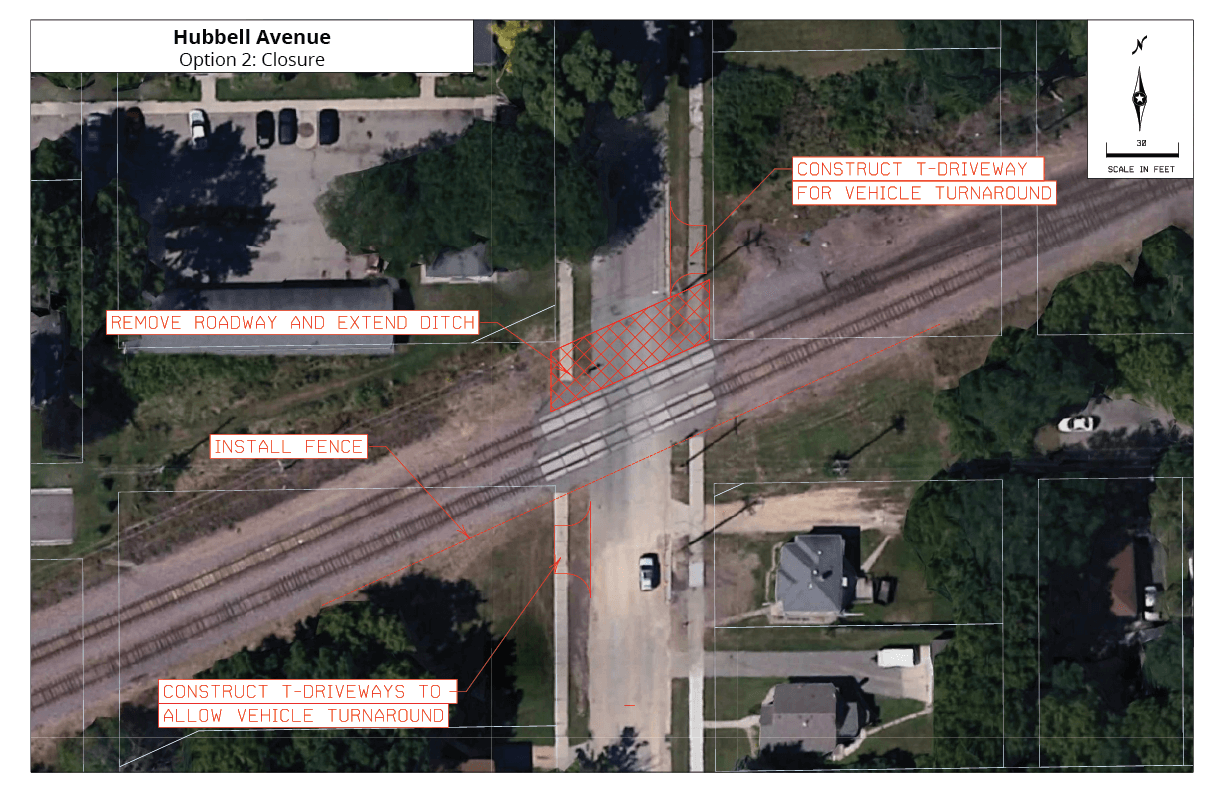
Your Feedback:
Owatonna
Baseline:
Cost: $512,400
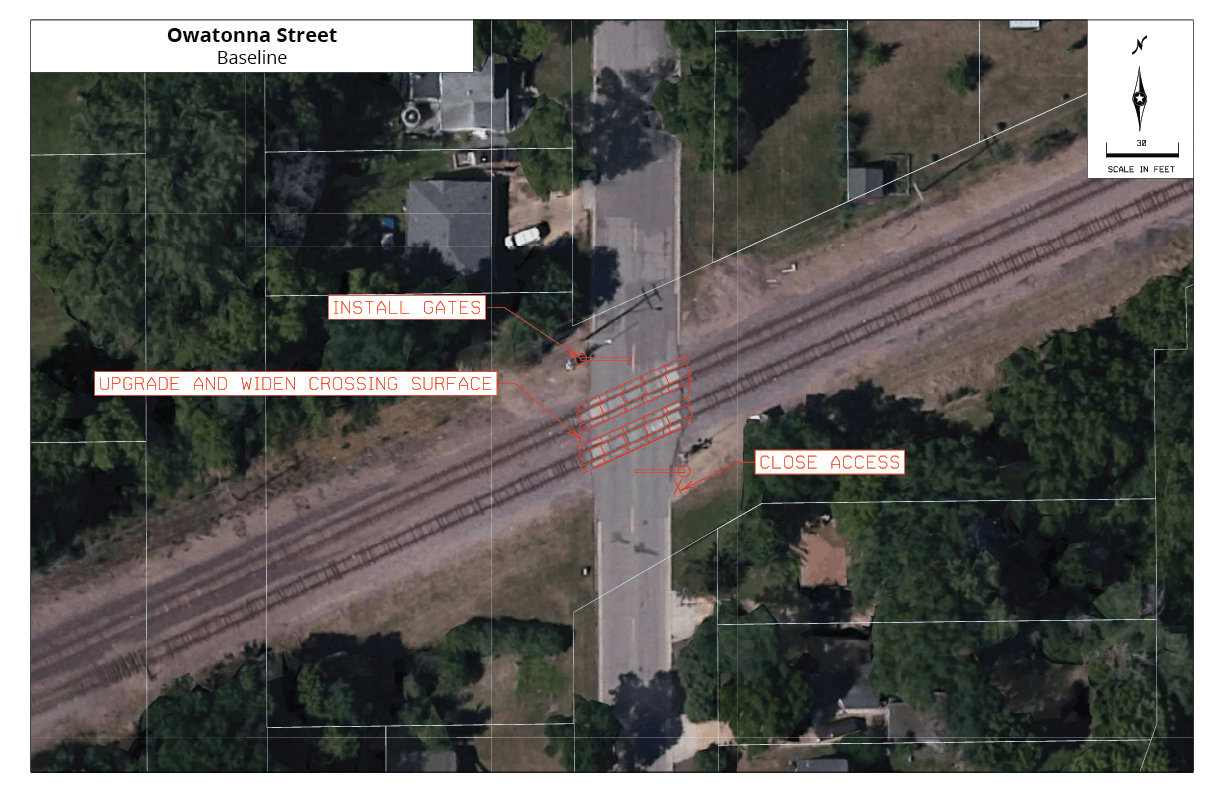
Option 1: Four-Quadrant Gates
Cost: $812,400
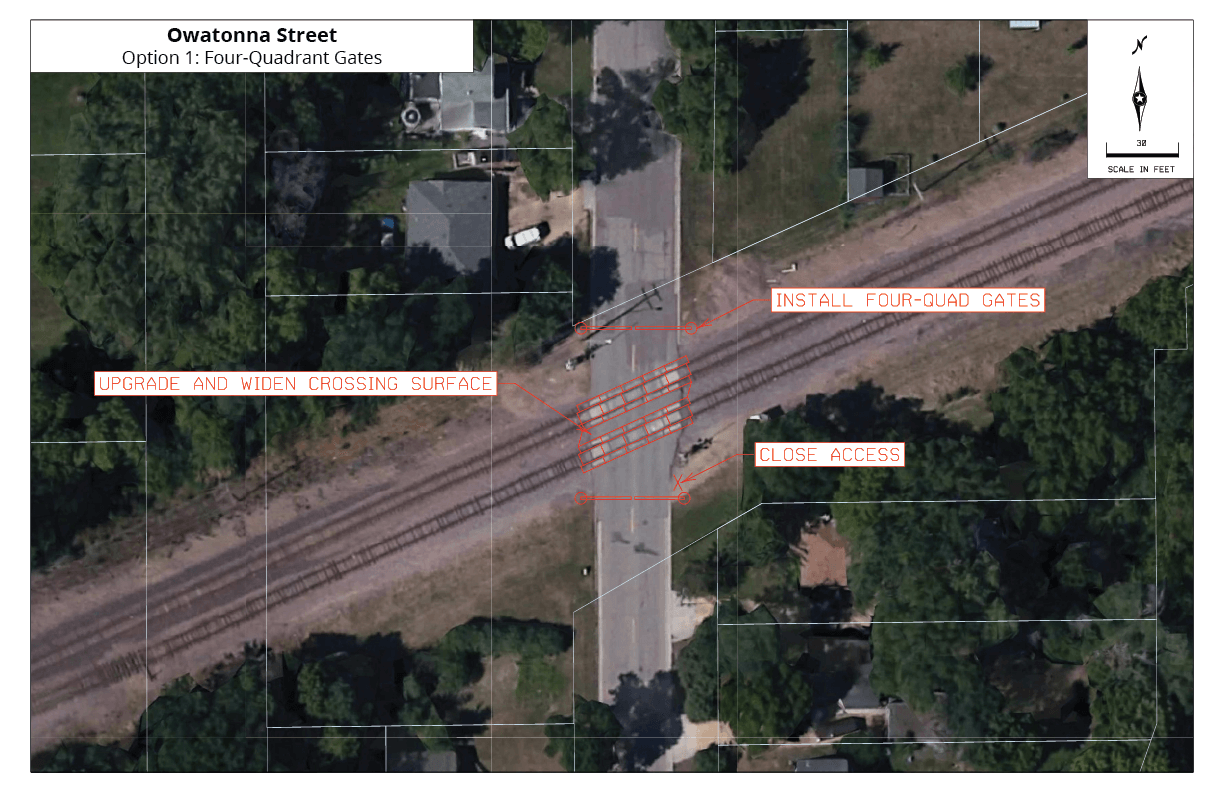
Option 2: Medians
Cost: $540,600
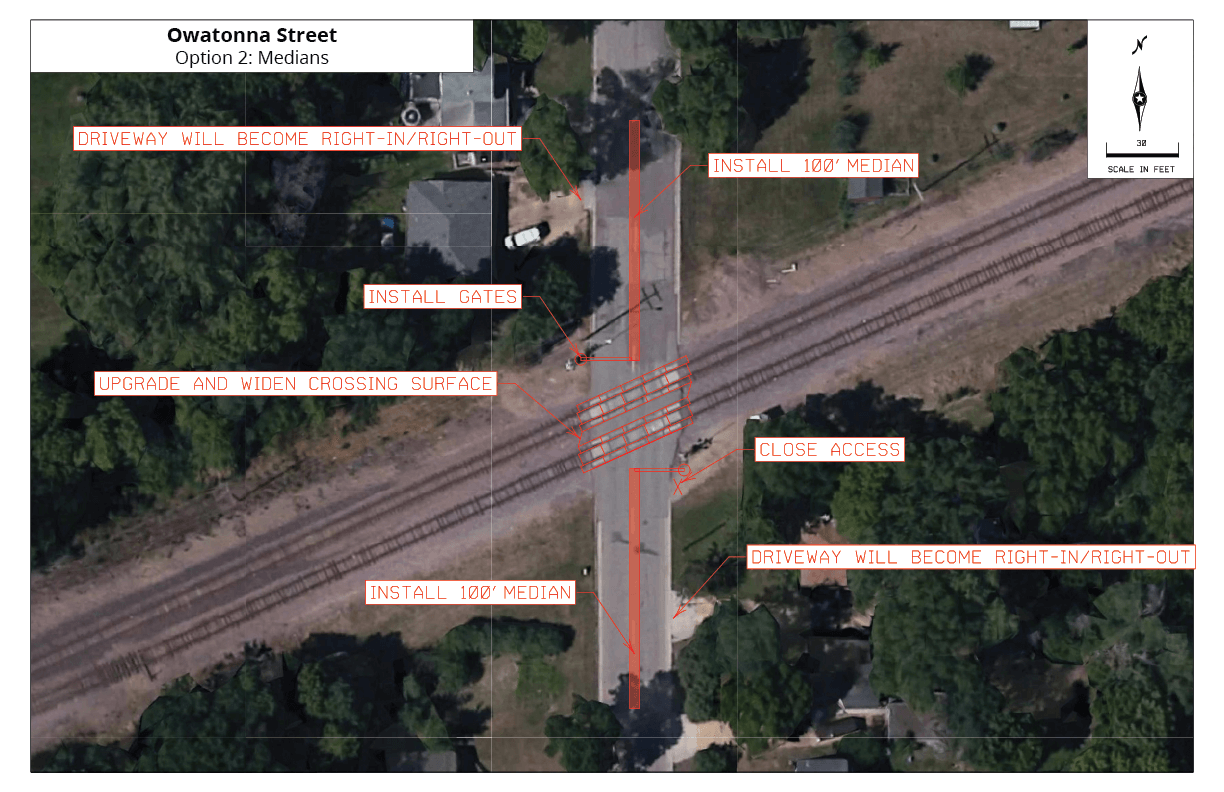
Option 3: Closure
Cost: $23,108
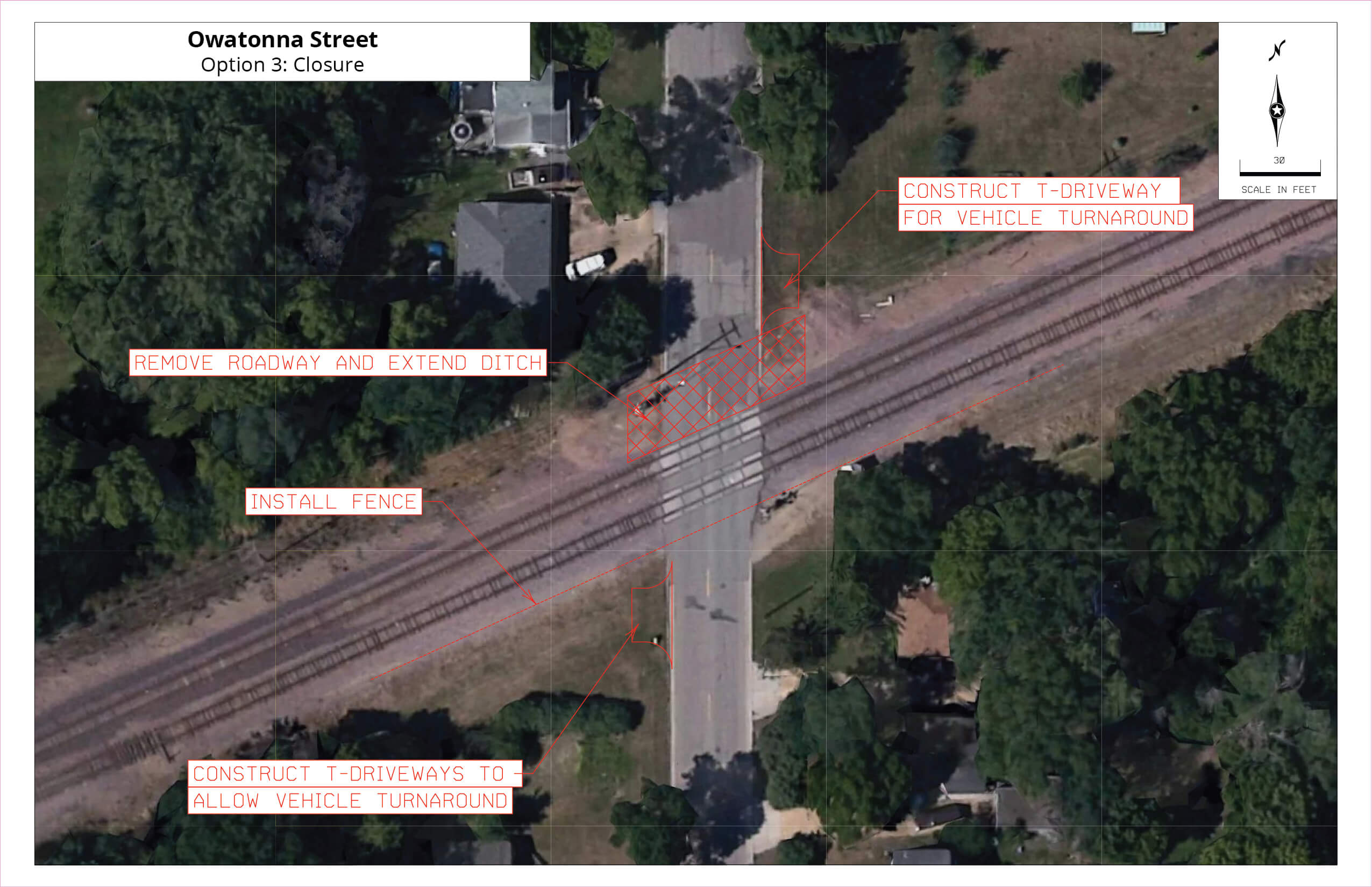
Your Feedback:
Pedestrian
Baseline:
Cost: $143,134
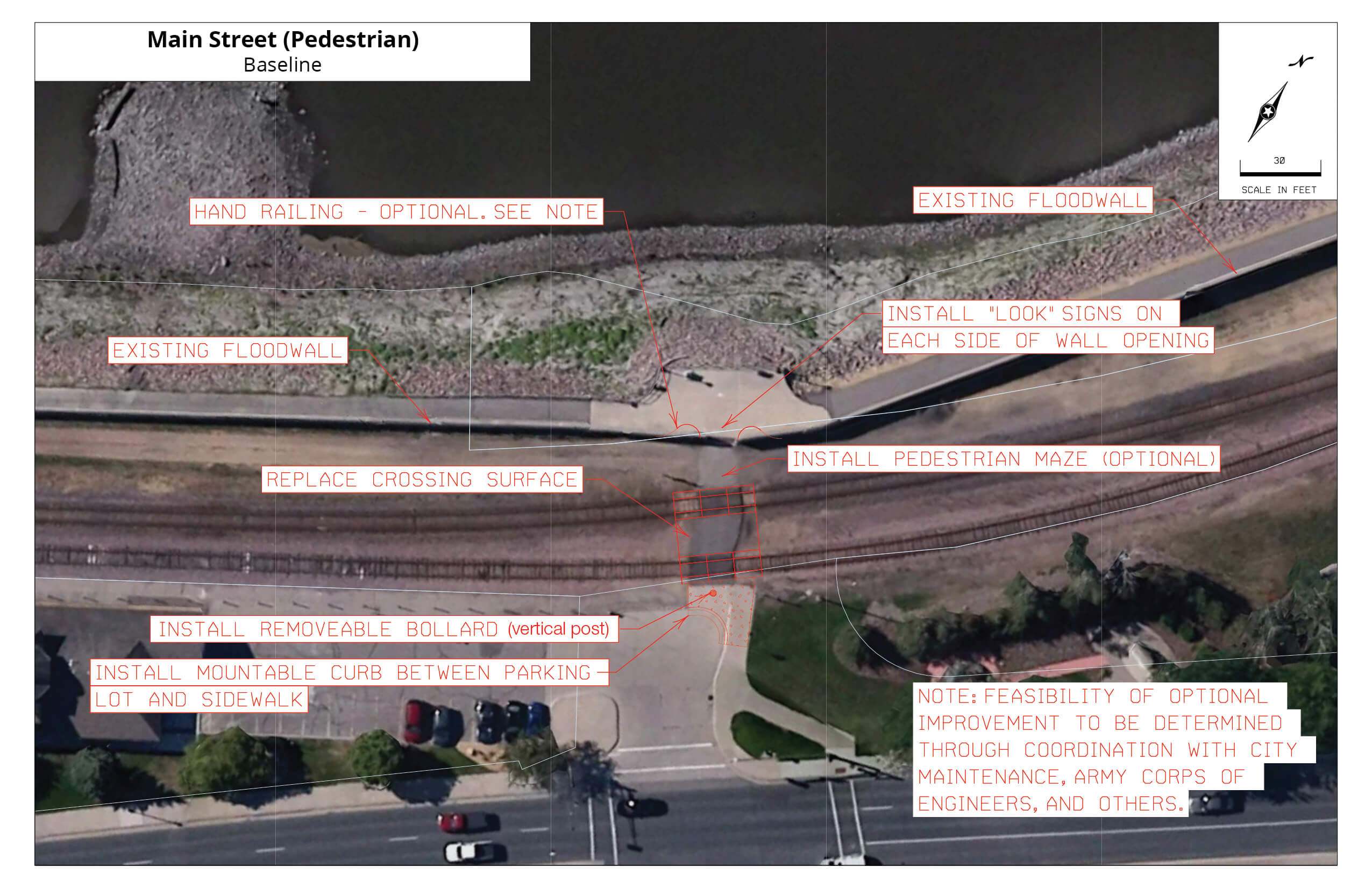
Your Feedback:
Elm/Willow
Baseline:
Cost: $724,800
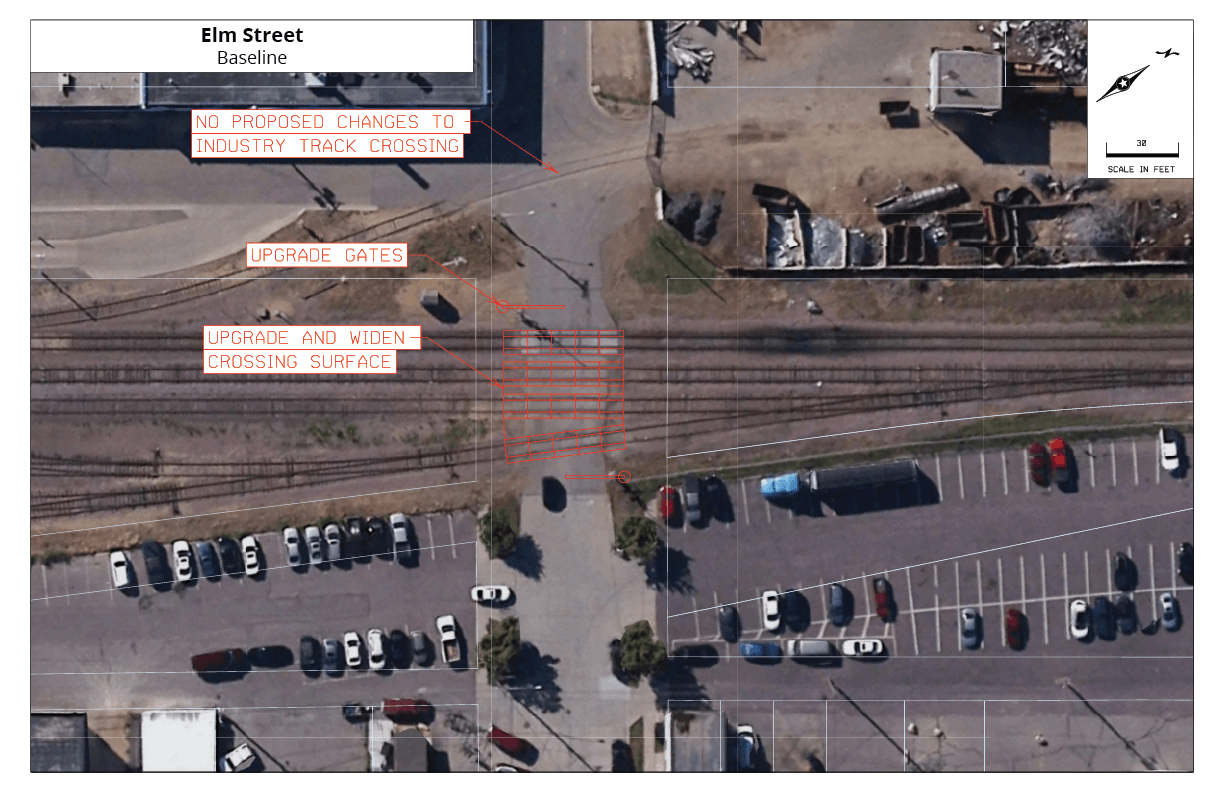
Option 1: Four-Quadrant Gates
Cost: $1,024,800
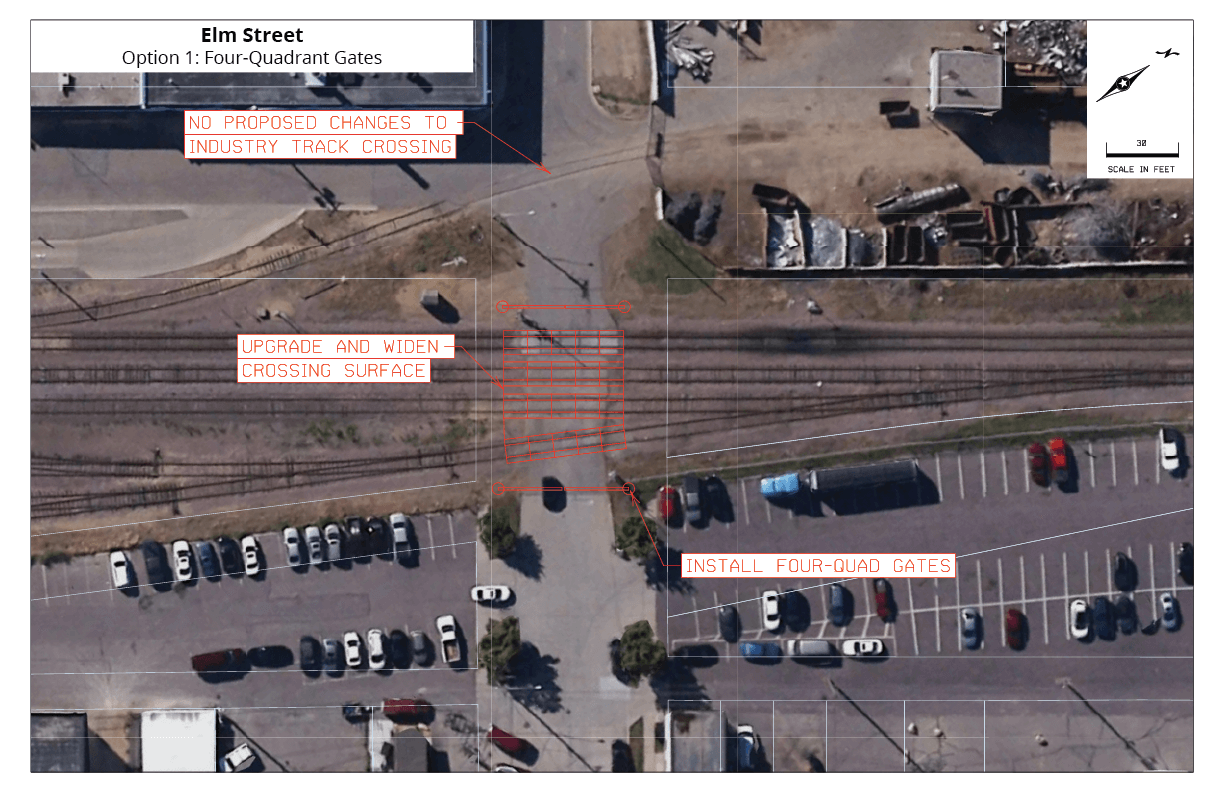
Option 2: One-Way Streets
Cost: $724,800
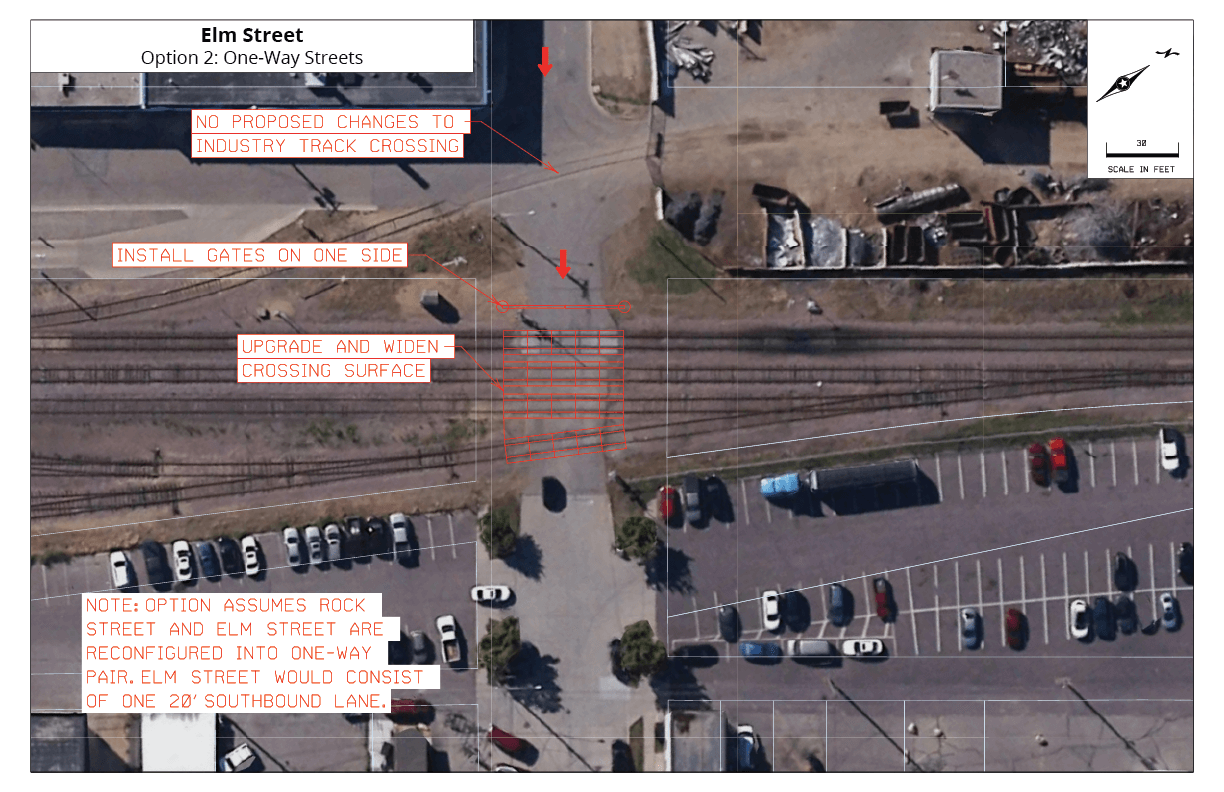
Estimated cost does not include costs associated with one-way street conversion.
Your Feedback:
Rock
Baseline:
Cost: $758,187
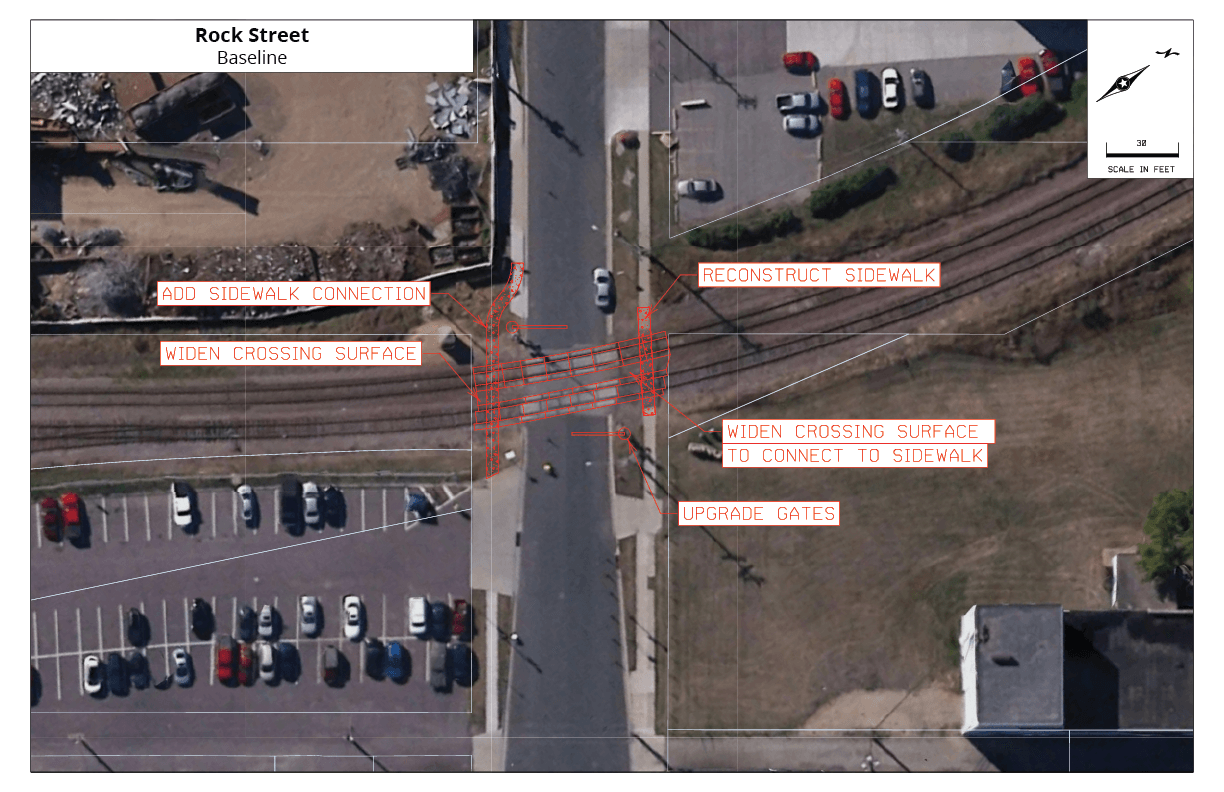
Option 1: Four-Quadrant Gates
Cost: $1,058,381
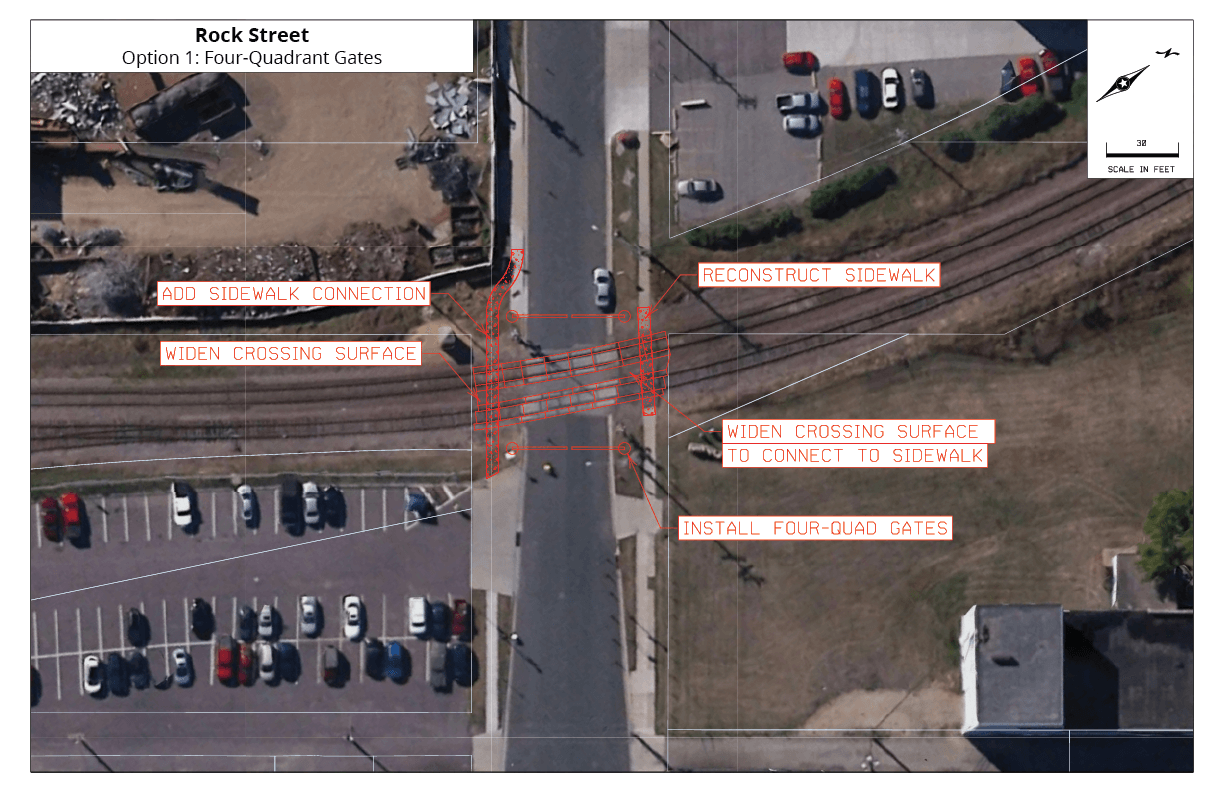
Option 2: One-Way Streets
Cost: $756,583
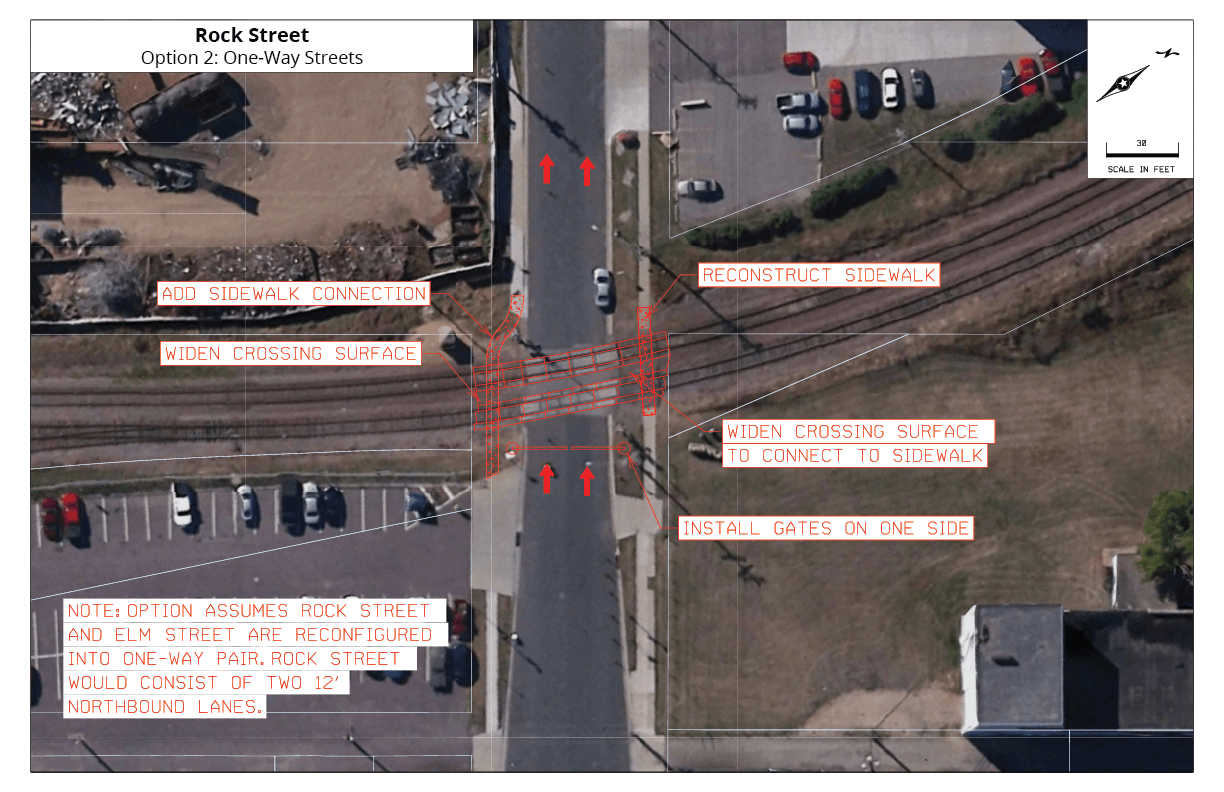
Estimated cost does not include costs associated with one-way street conversion.
Your Feedback:
Pine/5th
Option 1: Medians (Alternative Safety Measure)
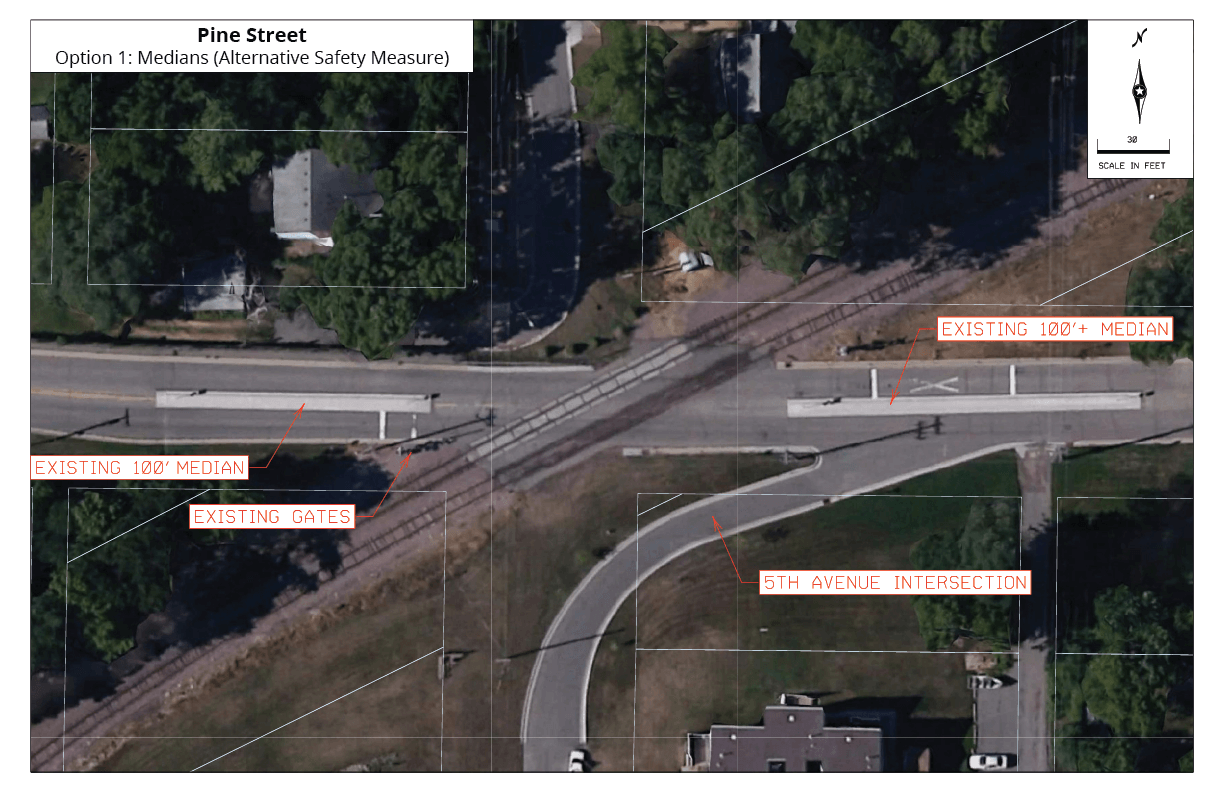
Your Feedback:
3rd
Baseline:
Cost: $86,500

Option 1: Four-Quadrant Gates
Cost: $693,856
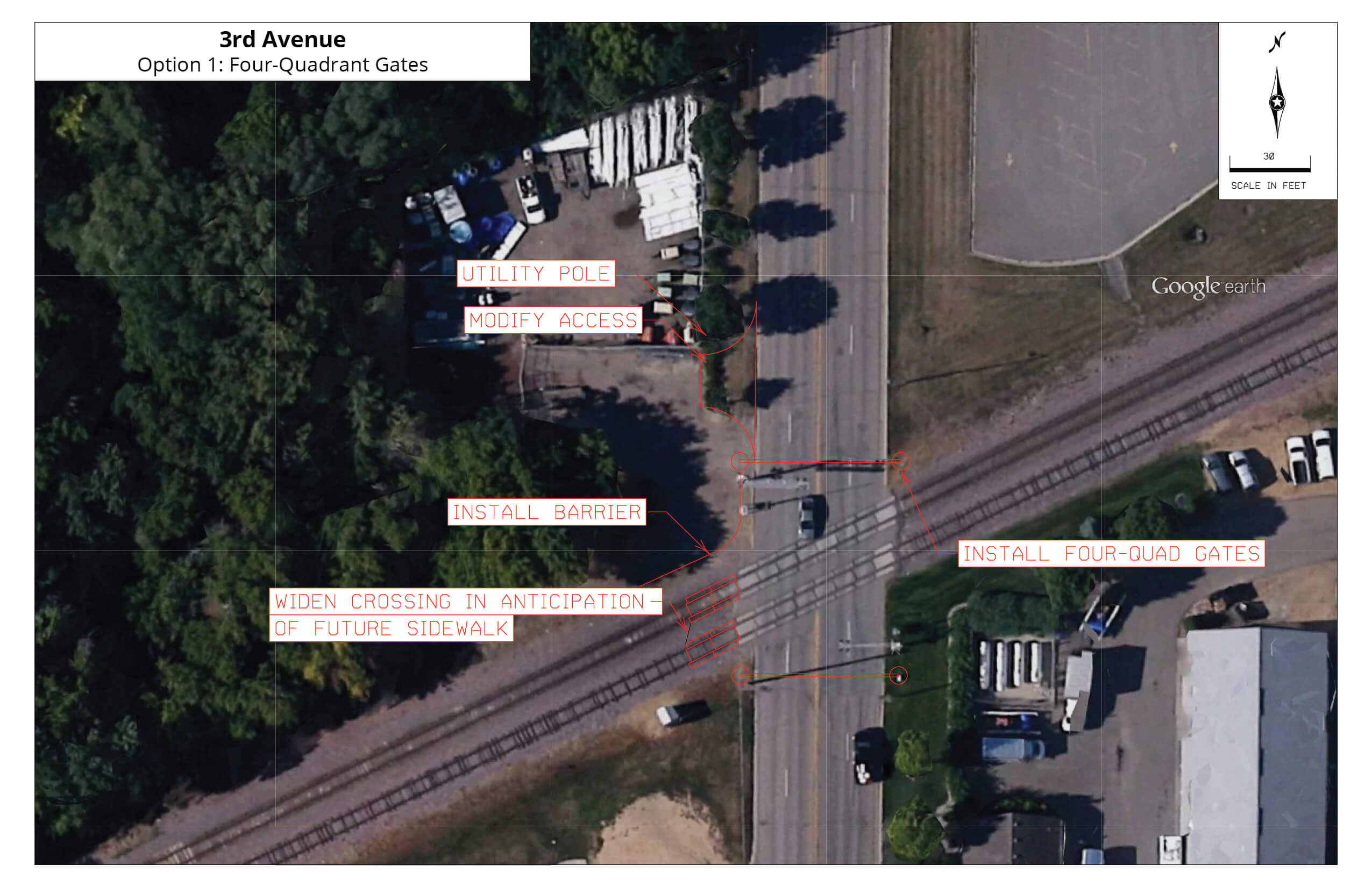
Option 2: Medians with 3-Lane
Cost: $119,264
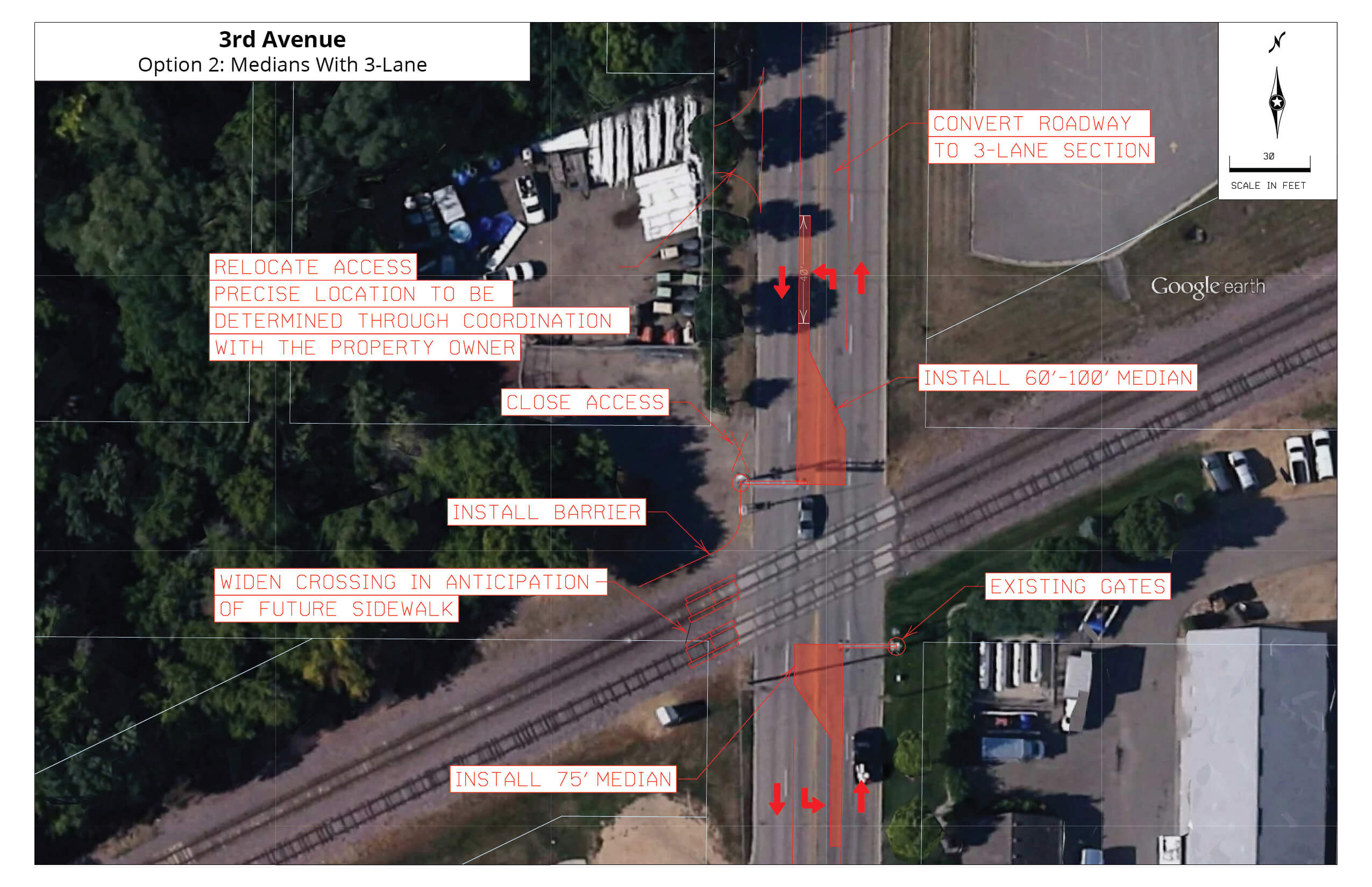
Option 3: Medians with 4-Lane
Cost: $237,481
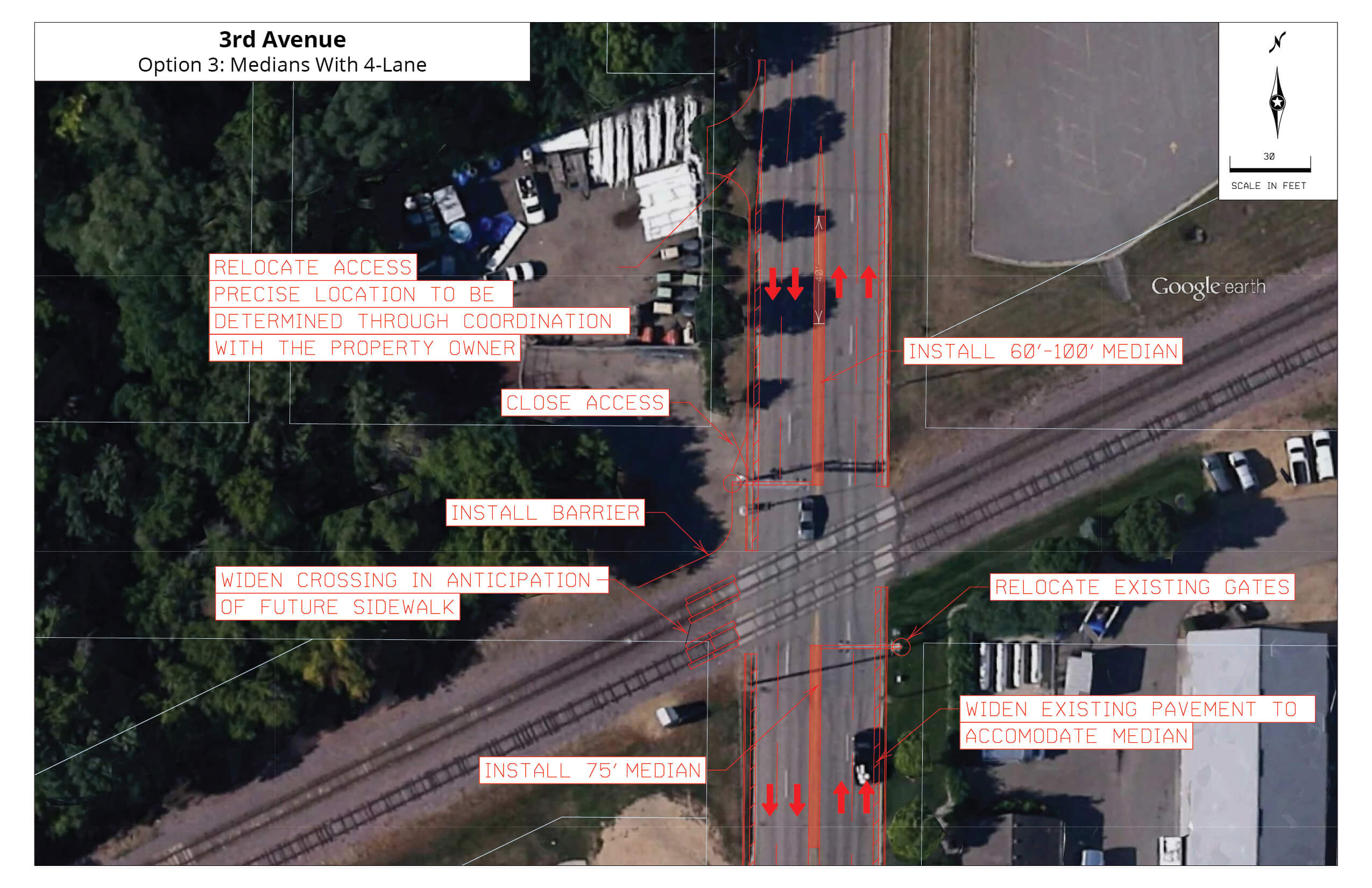
This option assumes that the proposed improvements would be coordinated with Blue Earth County's future roadway resurfacing of 3rd Avenue. The implementation of this option would also require a feasibility study to assess the impacts of a 4- to 3-lane conversion on traffic circulation and access. Estimated cost does not include costs associated with the feasibility study or roadway resurfacing project.
Your Feedback:
Industrial (Both Crossings)
Baseline:
Cost: $827,478
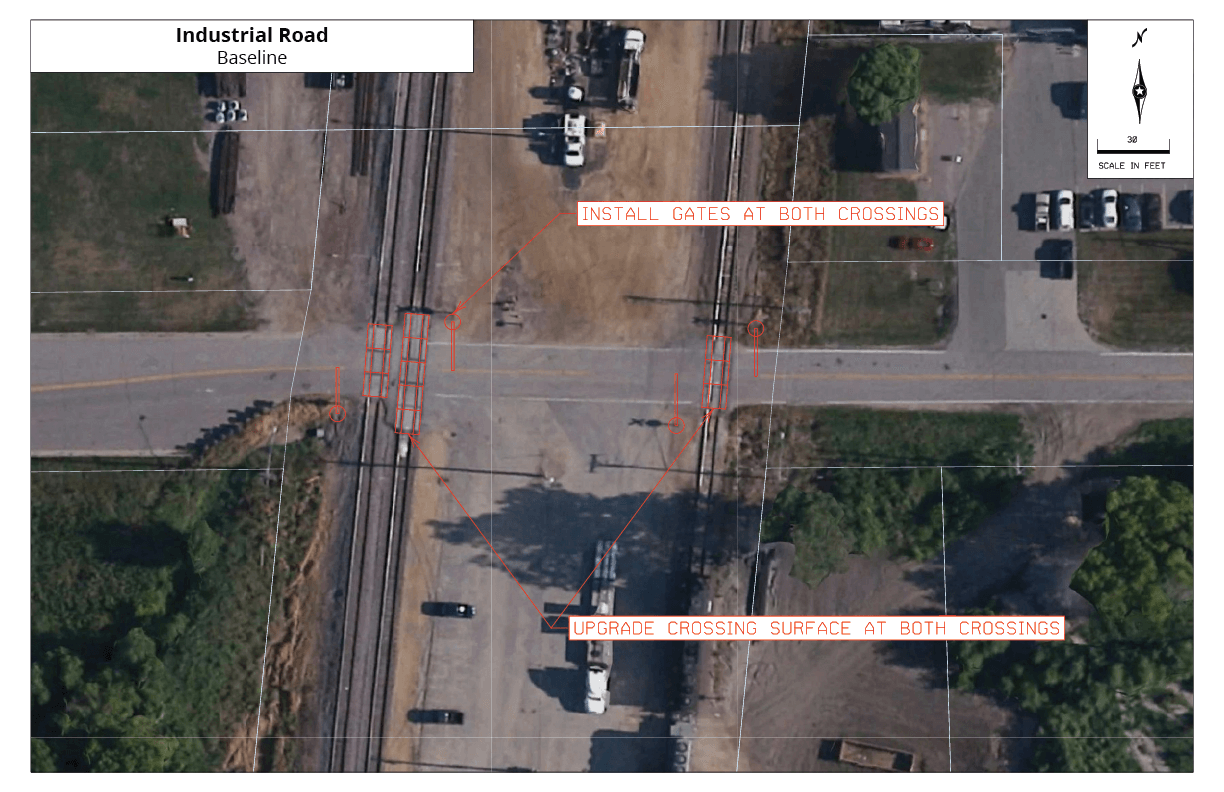
Your Feedback:
Proposed Implementation Scenarios
The following table summarizes five different potential implementation scenarios using various combinations of the proposed improvements discussed previously.
- Baseline: This scenario assumes only the installation of baseline improvements to achieve the minimum warning device requirements (gates, lights, CWT) for quiet zone implementation. Based on the FRA risk calculator, this approach would qualify for implementation by meeting the NSRT threshold. The risk analysis would be re-evaluated annually and would be subject to change through increased train or traffic volumes and highway-rail collisions. The NSRT is also updated annually. If an annual risk assessment finds the quiet zone is no longer in compliance, the City would be required to install additional safety improvements.
- Scenario 1, High Safety, Minimal Access Impacts: This scenario seeks to achieve high risk reduction while minimizing impacts to adjacent accesses. Under this scenario, Four-Quadrant gates are the preferred improvement options due to their minimal impacts to adjacent properties. No crossing closures are included in this scenario.
- Scenario 2, High Safety, Cost-Efficient (Avoid Four-Quadrant Gates): This scenario also seeks to achieve high risk reduction, but uses more cost-efficient improvement options such as non-traversable medians and closures.
- Scenario 3, Cost-Efficient: This scenario applies the most cost-efficient improvement options first until the quiet zone achieves risk reduction sufficient to meet the RIWH threshold.
- Scenario 4, Exclude Amos Owens, Cost-Efficient, Avoid Quiet Zone Application, No Closures: This scenario excludes Industrial Road and Amos Owens Lane from the quiet zone. It also applies the most cost-efficient improvement options first until the quiet zone achieves risk reduction sufficient to meet the RIWH threshold. Non-traversable medians are used at Hubbell Avenue in place of a crossing closure and a four-quadrant gate is used at Rock Street.
- Scenario 5, Phased/Partial Implementation: This scenario assumes the quiet zone is implemented in sections rather than as a full corridor.
- Subsection A: This section includes only 3rd Avenue and Pine Street/5th Avenue. Each of these crossings already meets the minimum warning device requirements. Pine Street/5th Avenue uses the Baseline improvement rather than the existing medians to avoid the need for a quiet zone application.
- Subsection B: This section includes only Rock Street, Elm Street, and the Pedestrian Crossings. Both vehicular crossings will need to be upgraded to meet the minimum warning device requirements. Installing Four-Quad Gates at Rock Street and not at Elm Street is sufficient to meet the RIWH threshold.
- Subsection C: This section includes only Owatonna Street and Hubbell Avenue. Both crossings will need to be upgraded to meet the minimum warning device requirements. Installing non-traversable medians at Hubbell Avenue only at Hubbell Avenue is sufficient to meet the RIWH threshold. Closing Hubbell Avenue would reduce the construction costs by roughly half, but would have impacts to local traffic circulation.
- Subsection D: This section includes only Amos Owens Lane. This crossing already meets the minimum warning device requirements.
| Street | Baseline | Scenario 1: High Safety, Minimal Access Impacts |
Scenario 2: High Safety, Cost-Efficient (Avoid Four-Quad Gates) |
Scenario 3: Cost-Efficient |
Scenario 4: Exclude Amos Owens, Cost-Efficient, Avoid Quiet Zone Application, No Closures |
Scenario 5: Phased/Partial Implementation |
|---|---|---|---|---|---|---|
| 3rd Ave | Baseline | Four-Quad Gates | Medians 3-Lane | Medians 4-Lane | Medians 3-Lane | Medians 3-Lane |
| Pine St and 5th Ave | Baseline | ASM Medians | ASM Medians | ASM Medians | Baseline | Baseline |
| Rock St | Baseline | Four-Quad Gates | Baseline | Baseline | Four-Quad Gates | Four-Quad Gates |
| Elm St | Baseline | Four-Quad Gates | Baseline | Baseline | Baseline | Baseline |
| Pedestrian | Baseline | Ped Improvements | Ped Improvements | Ped Improvements | Ped Improvements | Ped Improvements |
| Owatonna St | Baseline | Four-Quad Gates | Closure | Baseline | Baseline | Baseline |
| Hubbell Ave | Baseline | Medians | Medians | Closure | Medians | Medians |
| Amos Owens Ln | Baseline | Four-Quad Gates | Medians | Baseline | – | Medians |
| Cost | $2,875,000 | $5,070,000 | $2,585,000 | $2,406,000 | $3,212,000 | $50,000 – $2,000,000 |
| Existing Risk Level | 6,057 | 6,057 | 6,057 | 6,057 | 5,762 | Varies |
| Final Risk Level | 10,104 | 2,171 | 3,635 | 5,701 | 4,763 | Varies |
Next Steps
Thank you for participating in the Mankato Quiet Zone Study. Over the next few weeks, the study team will be incorporating the feedback from you and other stakeholders into a final report which will include additional details on the quiet zone review and implementation process, the improvement options considered, and the proposed implementation scenarios. The final report will also include a detailed implementation plan outlining the next steps required to implement a quiet zone in Mankato.
Share This Information
Please pass along the link to this virtual open house to your family, friends and coworkers. Use the options below to share this website through Facebook, Twitter, email, or SMS text message.
Share Additional Thoughts
If you haven’t already, please make sure to go back to the intersection slides and give us your feedback. To submit a general comment or question for the project team, click on the comment button in the top right corner of your screen.
Contact the Project Team
Chris Talamantez, City of Mankato Planner
ctalamantez@mankatomn.gov | (507) 387-8638
Join the Live Online Meeting
You are invited to join the project team's live online meeting:
Thursday, December 3 from 5 p.m. – 7 p.m.
Use this link to participate at the time of the event and enter the event password: MankatoRR
